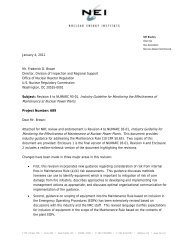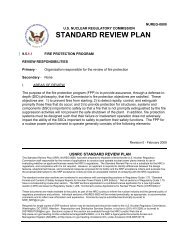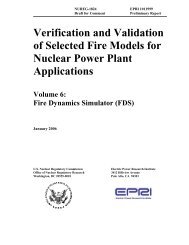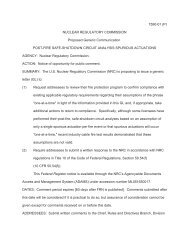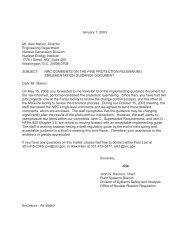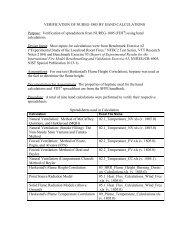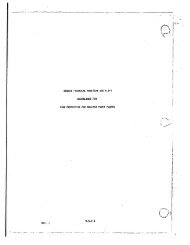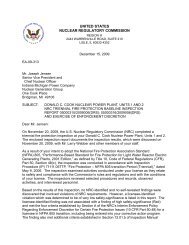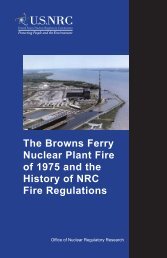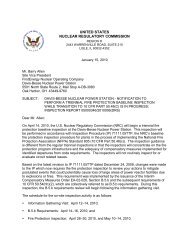NUREG/CR-6850, Volume 1 - NRC
NUREG/CR-6850, Volume 1 - NRC
NUREG/CR-6850, Volume 1 - NRC
Create successful ePaper yourself
Turn your PDF publications into a flip-book with our unique Google optimized e-Paper software.
IntroductionNote that this report does not address the verification and validation (V&V) process forcomputational fire models. A separate project is currently underway involving the RES and EPRIto V&V a select set of commonly applied computational fire models 1 in accordance with therequirements described in the ASTM E 1355-04, “Standard Guide for Evaluating the PredictiveCapability of Deterministic Fire Models”. Once completed, a joint EPRI and RES report will beprepared offering the results of this project for review and publication.The Fire PRA Methodology documented in this report complements, but does not overlapwith, the Fire Model V&V project. This document provides instructions for identification andcharacterization of fire scenarios, including the selection of key fire modeling input parameters.It also describes the types of fire modeling information needed to support the Fire PRA, andprovides a framework for the incorporation of fire modeling results. In those cases wherecomputational fire models are currently unable to address the fire behaviors of interest, thisreport provides empirical rule sets for the development and analysis of fire scenarios. However,with the notable exception of the probabilistic Main Control Board (MCB) approach documentedin Appendix L, and the flame spread and cable tray heat release rate models documented inAppendix R, this report does not rely on specific computational fire modeling tools. In fact, thisreport is not intended as a reference for the selection and/or evaluation of specific computationalfire modeling tools. The responsibility for the selection of appropriate computational fire modelslies with the PRA analyst, including providing a V&V basis for the selected tools.Note that the term “fire model” is defined rather broadly in this document to refer to any one of awide range of tools used to characterize and analyze fire scenarios. The <strong>NRC</strong>-RES/EPRI firemodel V&V project is focused on verification and validation of five commonly usedcomputational fire models.1.2.2 Program ApproachThe Fire Risk Requantification Study involved two Technical Development Teams, onerepresenting EPRI and the second representing RES. Each Technical Development Teamincludes an overall Technical Program Manager, and four individual Technical Area Expertscollectively representing the key technical disciplines: fire analysis, plant systems and PRAsystems analysis, electrical circuit failure modes and effects analysis, and human reliabilityanalysis (HRA). The primary responsibility of the Technical Development Teams was todocument (and/or develop) state-of-the-art Fire PRA methods, tools, and data and to seekresolution for methodological issues related to their areas of expertise. Although the principalintent was to document the state-of-the-art rather than conduct further research, the TechnicalDevelopment Teams did advance the state-of-the-art where realism and defensibility could beimproved with limited and focused investigations.1 The current compliment of computational fire modeling tools being addressed in the V&V effort are FIVE-Rev 1developed by EPRI (EPRI 1002981), the Fire Dynamics Tools (FDTs) developed by the <strong>NRC</strong> (<strong>NUREG</strong>-1805), theFrench zone fire model MAGIC developed by Electricite De France, the zone fire model CFAST developed byNIST, and the computational fluid dynamics model Fire Dynamics Simulator (FDS) developed by NIST.1-3





